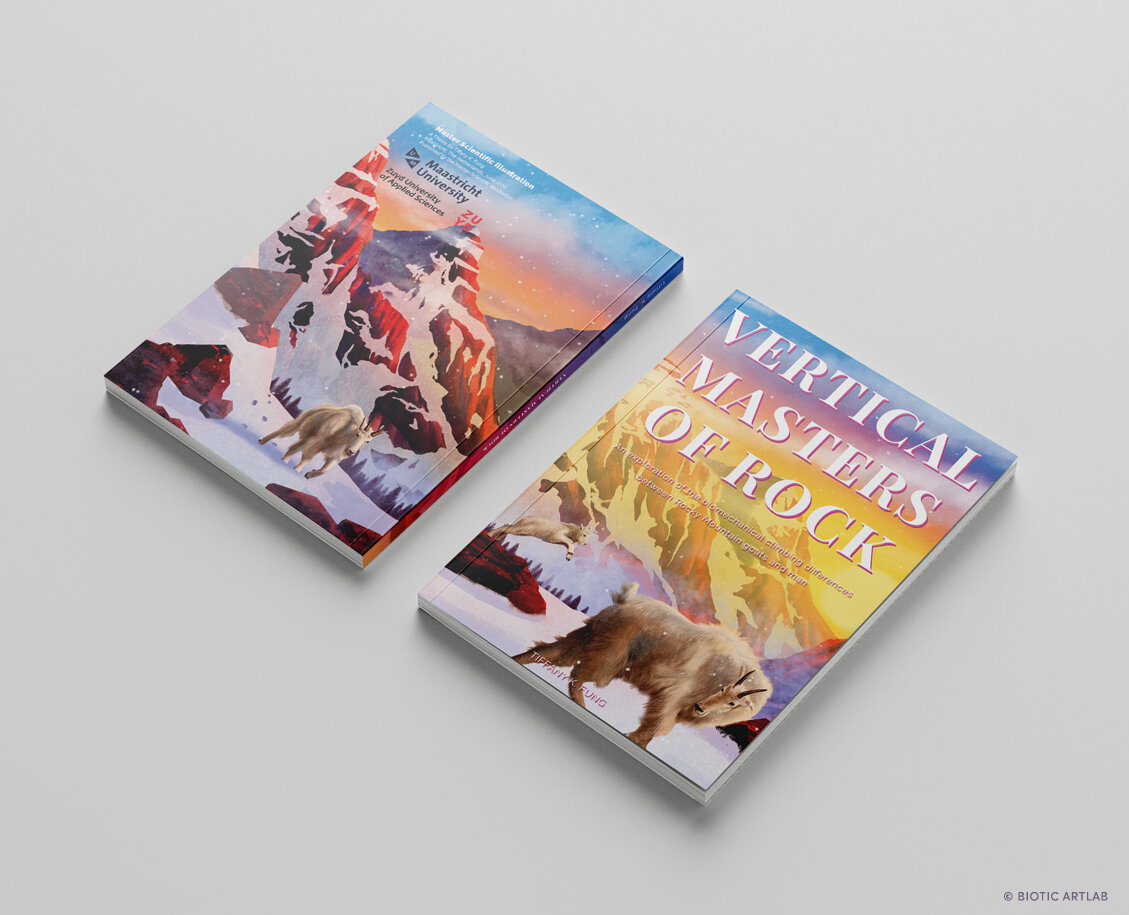
Comparative Anatomy of Rocky Mountain Goats and Climbers
Scroll down to learn more about how the biomechanics differences between human climbers and the rocky mountain goat allow both to perform at an elite level.
Client: University of Calgary, Sports Medicine University Hospital Center Rostock, Maastricht University, Zuyd Hogeschool
As a life-long rock climber, our Art Director, Tiffany Fung dove into the territory of comparative anatomy and physiology to better understand what makes humans such good climbers for her Master’s dissertation. To do this, she went through the lens of researching the Rocky Mountain goat (Oreamnos Americanus), a species of hoofed mammal endemic only to the mountainous areas of western North America. Weighing up to 310 lbs/140 kg, the Rocky Mountain goat has been documenting scaling sheer cliffs with speed that inspires awe.
She worked closely with a team of expert advisors that bridged the animal-human gap with advisors from the University of Calgary and the Sports Medicine University Hospital Center Rostock.
01 - Overview
Artists:
Tiffany Fung
02 - How do you tackle comparative anatomy and physiology?
The study of comparative anatomy and physiology is to look at the similarities and dissimilarities of these species’ structure. It helps determine evolutionary relationships between organisms and whether there is an identifiable common ancestor. In this dissertation, the visual research is broken down into 5 sections: environmental considerations, the importance of center of gravity, neck and shoulder, hoof structure, and human finger injuries.
ENVIRONMENT IS KEY: To first comprehend the impressiveness of Rocky Mountain goat climbing abilities, we explore the harsh terrain that they navigate daily for survival. RMGs can be found at elevations of 3400 m and above where they can outmaneuver larger predators like mountain lions, wolves, lynxes, and bears (oh my!). These 50+ degree cliffs weed out animals who do not have the same anatomy to friction grip onto the sandstone, limestone, shale conglomerate.
CENTER OF GRAVITY: Center of gravity is the key defining factor in balance and climbing. When managed properly, it allows a subject to scale vertical terrain with energy efficiency. A mountain goat’s forward center of mass combined with low center of gravity allows for it to nimbly navigate precarious landscapes. Moreover, if we take these two fundamentals into considerations, we can see how they apply to the human climber on varying steepnesses of walls.
NECK AND SHOULDER: Next, we look at the comparative anatomy of the neck and shoulder regions between species. We can see that the long spinous processes on the RMGs lend to large neck and upper back muscles that are key to pulling the heavy animal up and forward. In fact, 60% of a mountain goat’s body weight is carried in its front quarters due to this musculature.
Hoof Structure: These musculatures combined with the evolutionary masterpiece of their hoof structures lends them to be some of the best climbers of the hoofed, quadruped category. Modern day climbing shoe technology mimics this nature - grippy sole material to grab onto rock and aggressive pointed toe to direct force and increase precision.
FINGER INJURIES: While both animal and human body are evolutionary masterpieces, they are not exempt from injury. Human climbers have the ability to train their bodies to combat the physical barriers needed to climb. You can develop your shoulder muscles for better hauling ability, and train your core to maintain tension in overhangs. However the most common injuries that plague climbers occur in their hands and fingers.
This is because climbing exerts an extraordinary amount of force on your finger’s tendons. Sometimes the pulleys that keep the tendon close to the bone are not strong enough to withstand the force and result in a rupture. Other times, overuse causes inflammation in the tendon sheaths. Ultimately, finger conditioning and thoughtful training are key to a successful climbing career.
03 - Our Solution ✨
Through a mixture of traditional medical illustration, design, and animation, we investigated how human abilities can be better comprehended with a wider perspective angle. Even with our drastically different physiologies, we get the opportunity to explore this earth’s beautiful terrain.
Interested in buying prints of individual works? Contact us at info@biotic-artlab.com.
Let’s Chat
Do you need an infographic design for your presentation or publication? Reach out to us and we can start the conversation.










